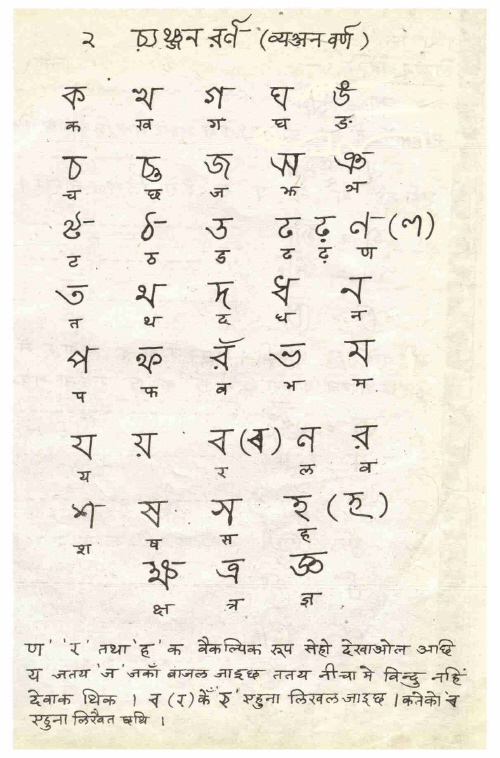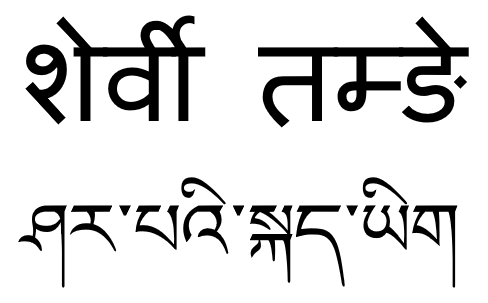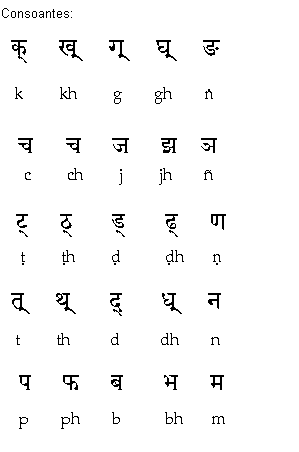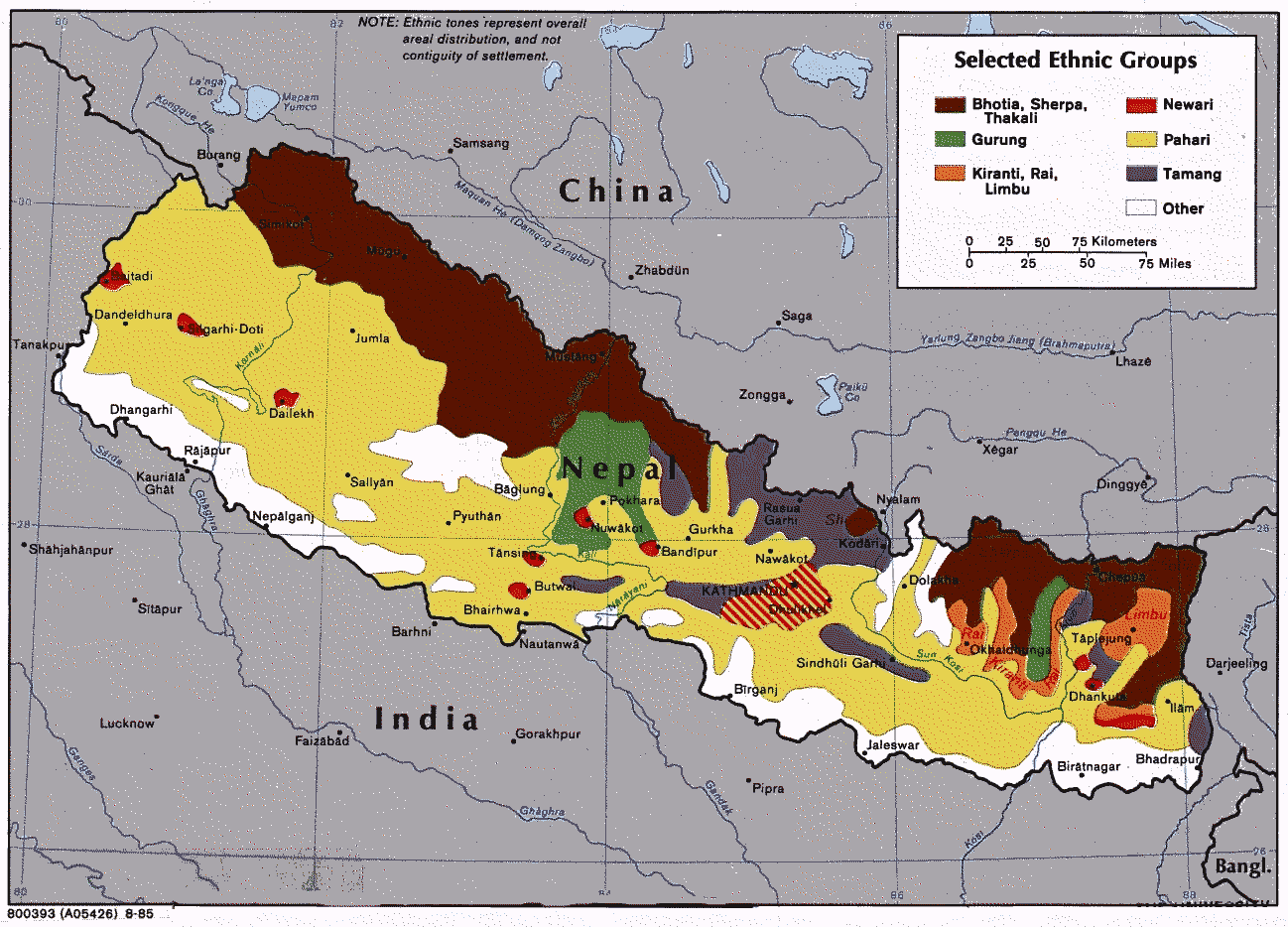|
Doramba Rural Municipality
Doramba is a Rural municipality located within the Ramechhap District of the Bagmati Province of Nepal. The municipality spans of area, with a total population of 22,738 according to a 2011 Nepal census. On March 10, 2017, the Government of Nepal restructured the local level bodies into 753 new local level structures. The previous Dadhuwa, Doramba, Tokarpur, Goshwara, Gunsi Bhadaure and Lakhanpur VDCs were merged to form Doramba Rural Municipality. Doramba is divided into 7 wards, with Tokarpur declared the administrative center of the rural municipality. Demographics At the time of the 2011 Nepal census, Doramba Rural Municipality had a population of 22,773. Of these, 51.9% spoke Nepali, 29.4% Tamang, 7.8% Thangmi, 4.9% Magar, 3.5% Newar, 1.4% Pahari, 0.7% Sherpa, 0.1% Maithili and 0.1% other languages as their first language. In terms of ethnicity/caste, 29.6% were Tamang, 24.9% Magar, 14.9% Newar, 7.8% Thami, 6.9% Hill Brahmin, 5.2% Chhetri, 4.3% Kami, 2.4% ... [...More Info...] [...Related Items...] OR: [Wikipedia] [Google] [Baidu] |
Gaunpalika
A gaunpalika ( ) is an administrative division in Nepal. The Ministry of Federal Affairs and Local Development (Nepal), Ministry of Federal Affairs and Local Development dissolved the existing Village development committee (Nepal), village development committees and announced the establishment of this new local body. It is a sub-unit of a List of districts of Nepal, district. There are currently 481 rural municipalities. History The village development committee (Nepal), village development committee was the previous governing body of villages in Nepal. They were replaced on 10 May 2017 by the rural municipalities which were formed by combining different VDCs. The decision was taken by the Council of Ministers of Nepal, cabinet of Nepal after modifications in the report proposed by the Local Level Restructuring Commission. Initially 481 rural municipalities were formed but it was later changed to 481 municipalities. According to the Ministry of Federal Affairs and Local Development ... [...More Info...] [...Related Items...] OR: [Wikipedia] [Google] [Baidu] |
Gunsi Bhadaure
Gunsi Bhadaure is a village development committee in Ramechhap District in the Janakpur Zone of north-eastern Nepal. At the time of the 1991 Nepal census The 1991 Nepal census was a widespread national census conducted by the Nepal Central Bureau of Statistics. Working with Nepal's Village Development Committees at a district level, they recorded data from all the main towns and villages of each ... it had a population of 4,945 people living in 895 individual households.. References External linksUN map of the municipalities of Ramechhap District Populated places in Ramechhap District {{Ramechhap-geo-stub ... [...More Info...] [...Related Items...] OR: [Wikipedia] [Google] [Baidu] |
Magars
The Magars, also spelled Mangar and Mongar, are the largest ethnic group native to Nepal and Northeast India, representing 6.9% of Nepal's total population according to the 2021 Nepal census. They are one of the main Gurkha tribes. The first home of the Magars was to the west of the Gandaki River and, roughly speaking, consisted of that portion of Nepal which lies between and around about Gulmi District, Gulmi, Arghakhanchi District, Arghakhanchi, and Palpa District, Palpa. This part of the country was divided into twelve districts known as ''Bahra Magarat'' (Confederation of Twelve Magar villages), which included the following regions of that period: Argha, Arghakhanchi District, Khanchi, Bhirkot, Dhor, Garhung, Ghiring, Gulmi, Isma, Musikot, Rising, Satungal, Satung, and Pyung. During the medieval period, the whole area from Palpa District, Palpa to Rukum Rolpa was called the Magarat, a place settled and inhabited by Magars. Another confederation of eighteen Magar kingdoms, k ... [...More Info...] [...Related Items...] OR: [Wikipedia] [Google] [Baidu] |
Tamang People
The Tamang people (; Devanagari: तामाङ; ''tāmāṅ'') are an ethnic group living in Nepal, Northeast India and southern Bhutan. In Nepal, they are concentrated in the central hilly and Himalayan regions and constituted over 1.6 million people in the 2021 census. In India, Tamang people live in the state of Sikkim, in the Darjeeling district, Darjeeling and Kalimpong districts of West Bengal and in Assam. In Bhutan, they live foremost in the southern foothills including Tsirang District, Dagana District, Samtse District, Chukha District, Sarpang District and Samdrup Jongkhar District. The Tamang language is the fifth most-spoken language in Nepal. History Research indicates that the Tamang people are a hybrid ethnic group with an estimated 59% genetic contribution from Tibetan and 41% from Nepalese ancestries. The Tamangs have been mentioned in various Nepalese and colonial historical records under a variety of names, such as ''Bhote'', ''Bodh'', ''Lama'', ''Murmi' ... [...More Info...] [...Related Items...] OR: [Wikipedia] [Google] [Baidu] |
Maithili Language
Maithili ( , ) is an Indo-Aryan language spoken in parts of India and Nepal. It is native to the Mithila region, which encompasses parts of the eastern Indian states of Bihar and Jharkhand as well as Nepal's Koshi Province, Koshi and Madhesh Provinces. It is one of the 22 scheduled languages of India. It is the second most commonly spoken native languages of Nepal, Nepalese language constitutionally registered as one of the fourteen provincial official languages of Nepal. It is spoken by 21.7 million people. Of those, 3.2 million are Nepalis, Nepalese speakers. The language is predominantly written in Devanagari, but the historical Tirhuta script, Tirhuta and Kaithi scripts retained some use until today. Official status In 2003, Maithili was included in the 8th Schedule, Eighth Schedule of the Indian Constitution as a recognised language of India, Indian language, which allows it to be used in education, government, and other official contexts in India. The Maithili language i ... [...More Info...] [...Related Items...] OR: [Wikipedia] [Google] [Baidu] |
Sherpa Language
Sherpa (also Sharpa, Sherwa, or Xiaerba) is a Tibetic language spoken in Nepal and the Indian state of Sikkim, mainly by the Sherpa. The majority speakers of the Sherpa language live in the Khumbu region of Nepal, spanning from the Chinese (Tibetan) border in the east to the Bhotekosi River in the west. About 127,000 speakers live in Nepal (2021 census), some 16,000 in Sikkim, India (2011), and some 800 in the Tibetan Autonomous Region (1994). Sherpa is a subject-object-verb (SOV) language. Sherpa is predominantly a spoken language, although it is occasionally written using either the Devanagari or Tibetan script. Classification Sherpa belongs to the Tibetic branch of the Tibeto-Burman family. It is closely related to Central Tibetan, Jirel, Humla, Mugom, Dolpo, Lo-ke, Nubri, Tsum, Langtang, Kyirong, Yolmo, Gyalsumdo, Kagate, Lhomi, Walung, and Tokpe Gola. Literary Tibetan ''LT''- becomes /lh/ and ''SR-'' becomes /ʈ/. There are five closely related dialect ... [...More Info...] [...Related Items...] OR: [Wikipedia] [Google] [Baidu] |
Pahari Language (Sino-Tibetan)
Pahari is an endangered Tibeto-Burman language spoken by about 3,500 people in central Nepal. Pahari is closely related to Newar, and has until recently been treated in the linguistic literature as a dialect of it. Pahari shares 55–65% of its basic vocabulary with Newar, which suggests the two are not mutually intelligible, and their speakers consider them to be separate languages. The language is endangered as it is no longer being passed on to the next generation. The ethnic population number (as of 2011), but only a quarter of them are native speakers of the language.; . Almost all Paharis speak Nepali, while some are also fluent in the ethnic languages of their neighbours, like Tamang or Newar. Pahari speakers are most numerous in Lalitpur district, but there are also communities in nearby regions: Sindhupalchok, Makwanpur, Ramechhap, Rautahat, Sindhuli and Kavre. There are at least two dialects – of Lalitpur and Sindhupalchok – and they are not mutually intellig ... [...More Info...] [...Related Items...] OR: [Wikipedia] [Google] [Baidu] |
Newar Language
Newar (; , ) is a Sino-Tibetan languages, Sino-Tibetan language spoken by the Newar people, the indigenous inhabitants of Nepal Mandala, which consists of the Kathmandu Valley and surrounding regions in Nepal. The language is known officially in Nepal as Nepal Bhasa, a name that has been historically used for the language. The term "Newari" is also used to refer to the language, although the Indic ''-i'' suffix is considered inappropriate by some Newar speakers. The language served as the official language of Nepal during the Malla dynasty (Nepal), Malla dynasty since the 14th century till the end of dynasty in 1769 during which the language was referred as "Nepal Bhasa", a term which literally means "Nepalese Language". However, the language is not the same as Nepali language, Nepali, an Indo-Aryan languages, Indo-Aryan language and the current official language of Nepal, which only got the name Nepali in the 1930s. Newar literature, Literature in Newar is one of the oldest i ... [...More Info...] [...Related Items...] OR: [Wikipedia] [Google] [Baidu] |
Magar Language
Magar Dhut (, ) is a Sino-Tibetan language spoken mainly in Nepal, southern Bhutan, and in Darjeeling, Assam and Sikkim, India, by the Magar people. It is divided into two groups (Eastern and Western) and further dialect divisions give distinct tribal identity. In Nepal 810,000 people speak the language. While the government of Nepal developed Magar language curricula, as provisioned by the constitution, the teaching materials have never successfully reached Magar schools, where most school instruction is in the Nepali language. It is not unusual for groups with their own language to feel that the "mother-tongue" is an essential part of identity. The Dhut Magar language is sometimes lumped with the Magar Kham language spoken further west in Bheri, Dhaulagiri, and Rapti zones. Although the two languages share many common words, they have major structural differences and are not mutually intelligible. Geographical distribution Western Magar Western Magar (dialects: ''Pal ... [...More Info...] [...Related Items...] OR: [Wikipedia] [Google] [Baidu] |
Thangmi Language
Thangmi, also called Thāmī, Thangmi Kham, Thangmi Wakhe, and Thani, is a Tibeto-Burman languages, Sino-Tibetan language spoken in central-eastern Nepal and northeastern India by the Thami, Thami people. The Thami refer to their language as ''Thangmi Kham'' or ''Thangmi Wakhe'' while the rest of Nepal refers to it as ''Thāmī''. The majority of these speakers, however, live in Nepal in their traditional homeland of Dolakha District, Dolakhā District. In India, the Thami population is concentrated mostly in Darjeeling. The Thangmi language is written using the Devanagari script. Thangmi has been extensively documented by Mark Turin. Distribution Thangmi is spoken in Bagmati Province, mainly in the region of Dolakha District, Dolakha; villages on Sailung Khola (The northern Salient (geography), panhandle of the Ramechhap District; mainly in Gokulganga Rural Municipality, Gokulganga); eastern regions of Sindhupalchok District, Sindhupalchowk District; and by some elders among the ... [...More Info...] [...Related Items...] OR: [Wikipedia] [Google] [Baidu] |
Tamang Language
Tamangic language is spoken mainly in Tamangsaling Land in Nepal, Sikkim, West Bengal (Darjeeling) and North-Eastern India. It comprises Eastern Tamang, Northwestern Tamang, Southwestern Tamang, Eastern Gorkha Tamang, and Western Tamang. Lexical similarity between Eastern Tamang (which is regarded as the most prominent) and other Tamang languages varies between 81% and 63%. For comparison, the lexical similarity between Spanish and Portuguese is estimated at 89%. Ethnologue report for Spanish Dialects ''Ethnologue'' divides Tamang into the following varieties due to mutual unintelligibility. *Eastern Tamang: 759,000 in Nepal (2000 WCD). Population total all countries: 773,000. Sub-dialects are as follows. **Outer-Eastern Tamang (Sailung Tamang) **Central-Eastern Tamang (Temal Tamang) **Southwestern Tamang (Kath-Bhotiya, Lama Bhote, Murmi, Rongba, Sain, Tamang Gyoi, Tamang Gyot, Tamang Lengmo, Tamang Tam) *Western Tamang: 323,000 (2000 WCD). Sub-dialects are as follows. ** ... [...More Info...] [...Related Items...] OR: [Wikipedia] [Google] [Baidu] |
Nepali Language
Nepali (; , ), or ''Gorkhali'' is an Indo-Aryan languages, Indo-Aryan language native to the Himalayas region of South Asia. It is the official and most widely spoken Languages of Nepal, language of Nepal, where it also serves as a ''lingua franca''. Nepali has Languages with official status in India, official status in the Indian state of Sikkim and in the Gorkhaland Territorial Administration of West Bengal. It is spoken by about a quarter of Bhutan's population. Nepali also has a significant number of speakers in the Indian states of Arunachal Pradesh, Assam, Himachal Pradesh, Manipur, Meghalaya, Mizoram and Uttarakhand. In Myanmar it is spoken by the Burmese Gurkhas. The Nepali diaspora in the Middle East, Brunei, Australia and worldwide also use the language. Nepali is spoken by approximately 19 million native speakers and another 14 million as a second language. Nepali is commonly classified within the Eastern Pahari group of the Northern Indo-Aryan languages, Northern zo ... [...More Info...] [...Related Items...] OR: [Wikipedia] [Google] [Baidu] |




